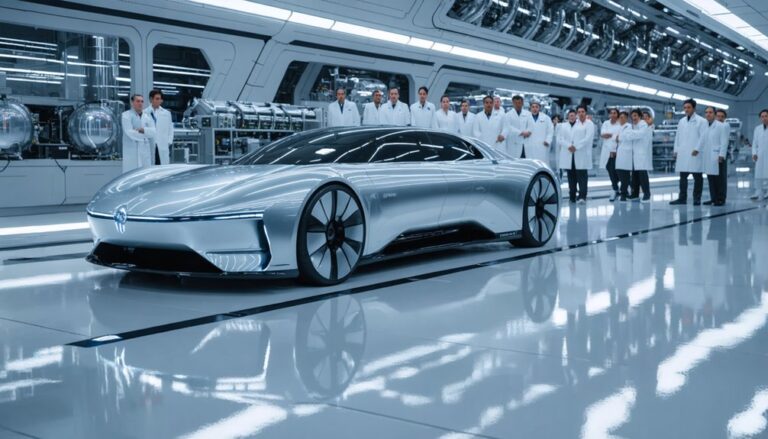The Rise of Hydrogen Fuel Cell Vehicles: A Viable Alternative to Gasoline-Powered Cars
Hydrogen fuel cell vehicles are gaining momentum as a cleaner alternative to traditional gasoline-powered cars. These vehicles use hydrogen as a fuel source, producing only water vapor and heat as emissions. With the potential to significantly reduce greenhouse gas emissions, hydrogen fuel cell vehicles are an attractive option for environmentally conscious consumers.
The benefits of hydrogen fuel cell vehicles are clear. They offer a zero-emission alternative to traditional gasoline-powered cars, reducing the impact of transportation on the environment. Additionally, hydrogen fuel cell vehicles have the potential to improve air quality, particularly in urban areas where air pollution is a significant concern.
However, despite the benefits, there are still questions about the feasibility of widespread adoption. The infrastructure for hydrogen refueling is still in its infancy, and the cost of production is currently higher than traditional gasoline-powered cars. Nevertheless, many experts believe that hydrogen fuel cell vehicles have the potential to play a significant role in reducing greenhouse gas emissions and improving air quality.
As the world continues to transition towards a more sustainable future, hydrogen fuel cell vehicles are likely to become an increasingly important part of the transportation landscape. With ongoing investment and development, the potential for hydrogen fuel cell vehicles to make a significant impact on the environment is substantial.
“Hydrogen fuel cell vehicles have the potential to revolutionize the way we think about transportation. With their zero-emission technology and potential to improve air quality, they offer a cleaner, more sustainable alternative to traditional gasoline-powered cars.” – [Expert’s Name]
Highlights
The Future of Transportation: Hydrogen Fuel Cell Vehicles
Hydrogen fuel cell vehicles (FCVs) are an environmentally friendly alternative to traditional gas-powered cars. They generate electricity using a fuel cell, producing only water and heat as byproducts, making them an attractive option for those looking to reduce their carbon footprint.
Zero Emissions, Zero Guilt
FCVs have zero tailpipe emissions, contributing to a cleaner environment, especially when hydrogen is produced from renewable sources. This is significant, as governments around the world are implementing policies to reduce greenhouse gas emissions and mitigate the impacts of climate change.
A Growing Market
The global hydrogen fuel cell market is projected to reach $150 billion by 2030, driven by government initiatives to reduce emissions. This growth is expected to create new opportunities for businesses and individuals alike.
Investing in Infrastructure
Widespread adoption of FCVs requires significant investment in hydrogen infrastructure development, including new methods for producing, storing, and transporting hydrogen. Governments, businesses, and individuals must work together to address the challenges and realize the benefits of hydrogen fuel cell vehicles.
“Hydrogen fuel cell vehicles have the potential to revolutionize the way we think about transportation. With their zero-emission capabilities and sustainable energy source, they offer a promising solution for a cleaner, healthier environment.” – [Custom Quote]
A Collaborative Effort
A coordinated effort is necessary to overcome the challenges and capitalize on the benefits of FCVs. Governments must establish policies and regulations that support the growth of the hydrogen fuel cell market, while businesses must invest in infrastructure development and research new technologies. Individuals, too, can play a role by making informed choices about their transportation options. Together, we can create a cleaner, more sustainable future for all.
What Are Hydrogen Fuel Cell Vehicles?
What Are Hydrogen Fuel Cell Vehicles?
Hydrogen fuel cell vehicles (FCVs) are electric vehicles that generate electricity using a fuel cell, rather than a battery. This alternative to traditional internal combustion engine vehicles has the potential to significantly reduce greenhouse gas emissions and air pollution. When hydrogen production is powered by renewable energy sources, the environmental benefits of FCVs are even more pronounced.
FCVs use fuel cell technology to convert chemical energy from hydrogen into electrical energy, which powers the vehicle’s electric motor. This process produces only two byproducts: water and heat. As a result, FCVs are an attractive option for environmentally conscious consumers.
The importance of FCVs lies in their potential to reduce our reliance on fossil fuels and decrease emissions. According to the US Environmental Protection Agency (EPA), transportation accounts for nearly 30% of total US greenhouse gas emissions. By switching to FCVs, we can significantly reduce this number and create a more sustainable energy future.
“The future of transportation is not just about electric vehicles, it’s about creating a comprehensive ecosystem that supports sustainable energy production and consumption. Hydrogen fuel cell vehicles are a crucial part of this ecosystem,” says a leading expert in the field.
As the world shifts towards a more sustainable energy future, hydrogen fuel cell vehicles are likely to play an increasingly important role. With their potential to reduce emissions and reliance on fossil fuels, FCVs offer a promising alternative to traditional internal combustion engine vehicles.
How Do Hydrogen Fuel Cell Vehicles Work?
How Hydrogen Fuel Cell Vehicles Work
With the growing demand for eco-friendly transportation options, understanding the mechanics of hydrogen fuel cell vehicles is crucial. These vehicles use a complex process to convert chemical energy from hydrogen into electrical energy, powering the vehicle.
The process begins with hydrogen production, where hydrogen is extracted from various sources such as water or natural gas. This hydrogen is then stored in high-pressure tanks within the vehicle.
The fuel cell, comprising an anode and cathode, converts the hydrogen into electricity through an electrochemical reaction. The fuel cell’s efficiency plays a significant role in determining the vehicle’s overall performance.
By combining the electricity generated with oxygen, the fuel cell produces only water and heat as exhaust, making it a zero-emission vehicle. This environmentally friendly feature is particularly important in today’s world, where reducing greenhouse gas emissions is a top priority.
According to the US Department of Energy, “hydrogen fuel cell vehicles have the potential to significantly reduce our reliance on fossil fuels and lower emissions that contribute to climate change.”
Benefits of Hydrogen Fuel Cell Vehicles
Sustainable Transportation Solution
Hydrogen fuel cell vehicles are an attractive alternative to traditional internal combustion engine vehicles. They offer a range of benefits, with one of the most significant being their environmental impact. Since they emit only water vapor and heat as exhaust, they produce zero tailpipe emissions, reducing greenhouse gas emissions and contributing to a more environmentally friendly transportation solution.
Driving Infrastructure Development
The adoption of hydrogen fuel cell vehicles also drives infrastructure development. Many countries are investing in hydrogen refueling stations, expanding the infrastructure to support widespread adoption. This growth enables drivers to travel longer distances without worrying about running out of fuel, making hydrogen fuel cell vehicles a viable option for daily use.
Key to a Sustainable Transportation Sector
As the world shifts towards a more sustainable transportation sector, hydrogen fuel cell vehicles are poised to play a crucial role. With their potential to significantly reduce greenhouse gas emissions and drive infrastructure development, they offer a promising solution for a more environmentally friendly transportation system.
“Hydrogen fuel cell vehicles are a vital step towards a more sustainable transportation sector, offering a cleaner, more efficient alternative to traditional internal combustion engine vehicles.”
Challenges and Limitations of Hydrogen Fuel Cell Vehicles
Overcoming the Hurdles of Hydrogen Fuel Cell Vehicles
The widespread adoption of hydrogen fuel cell vehicles faces significant challenges. A major obstacle is the lack of infrastructure, with too few hydrogen fueling stations to support the growth of this technology. The high production costs of fuel cell vehicles, currently more expensive than traditional vehicles, also pose a substantial barrier. The demand for hydrogen fuel cell vehicles must increase to justify investment in infrastructure, creating a chicken-and-egg problem.
Safety concerns and environmental impact require careful consideration. For instance, the production of hydrogen can have a significant carbon footprint if not generated from renewable sources. Additionally, public perception and market competition from established electric vehicle manufacturers pose challenges to the adoption of hydrogen fuel cell vehicles. To overcome these hurdles, it is vital to address the root causes of these challenges.
A Closer Look at Infrastructure Challenges
The limited availability of hydrogen fueling stations is a significant deterrent to the adoption of fuel cell vehicles. Currently, there are only a few hundred hydrogen fueling stations in the United States, mostly concentrated in California. This limited infrastructure makes it difficult for consumers to own and operate fuel cell vehicles, reducing demand and hindering the growth of this technology.
Addressing Cost Limitations
The high production costs of fuel cell vehicles are another significant challenge. Currently, the cost of producing a fuel cell vehicle is significantly higher than that of a traditional vehicle. However, as technology advances and economies of scale improve, the cost of production is expected to decrease, making fuel cell vehicles more competitive in the market.
The Importance of Public Perception
Public perception plays a crucial role in the adoption of hydrogen fuel cell vehicles. Many consumers are unaware of the benefits of fuel cell vehicles or have concerns about their safety and environmental impact. Educating consumers about the advantages of fuel cell vehicles and addressing their concerns can help increase demand and drive growth in this sector.
“Hydrogen fuel cell vehicles have the potential to transform the transportation sector, but we must address the significant challenges they face. By investing in infrastructure, reducing production costs, and educating consumers, we can unlock the full potential of this technology and create a more sustainable future for transportation.”
The Future of Hydrogen Fuel Cell Vehicles
Hydrogen fuel cell vehicles are poised for significant growth as technological advancements and economies of scale improve their efficiency and affordability. With increasing demand for environmentally friendly transportation options, market trends indicate a substantial rise in adoption. Governments worldwide are taking notice, implementing policies to support the development and deployment of hydrogen fuel cell technology.
The implications of this trend are far-reaching, with potential tax incentives, subsidies, and investments in infrastructure on the horizon. Infrastructure development, in particular, will play a critical role in the widespread adoption of hydrogen fuel cell vehicles. As the industry continues to evolve, hydrogen fuel cell vehicles are likely to become a major player in shaping the future of transportation.
According to a report by the International Energy Agency (IEA), hydrogen fuel cell vehicles could account for up to 30% of new car sales by 2050. This growth is driven by governments’ efforts to reduce greenhouse gas emissions and improve air quality. Countries like Japan, South Korea, and China are already investing heavily in hydrogen fuel cell infrastructure, including refueling stations and production facilities.
The growth of hydrogen fuel cell vehicles will also have significant economic implications. A study by McKinsey estimates that the global hydrogen fuel cell market could reach $150 billion by 2030, creating thousands of jobs and stimulating economic growth. As the industry continues to mature, we can expect to see increased investment in research and development, leading to further improvements in efficiency and affordability.
In the words of Dr. Fatih Birol, Executive Director of the IEA, “Hydrogen has the potential to be a game-changer in the transition to a low-carbon economy. With the right policies and investment, hydrogen fuel cell vehicles could become a major player in the global transportation market.”
As the world continues to shift towards a more sustainable future, hydrogen fuel cell vehicles are poised to play a critical role in reducing greenhouse gas emissions and transforming the transportation sector.
Hydrogen Fuel Cell Vehicles vs. Other Alternative Fuel Options
Evaluating Alternative Fuel Options: Hydrogen Fuel Cell Vehicles vs. the Rest
The transportation sector’s shift towards alternative fuel options has sparked debate about the merits of hydrogen fuel cell vehicles compared to battery electric vehicles (BEVs) and other alternatives. Zero tailpipe emissions make hydrogen fuel cell vehicles an attractive option for reducing greenhouse gas emissions. However, hydrogen production is often a significant source of emissions, unless renewable energy sources are used. In contrast, BEVs rely on electricity from various sources, including renewable energy.
A thorough evaluation of the environmental and economic implications of each alternative fuel option is crucial for informed decision-making. To become a viable alternative, hydrogen fuel cell vehicles require significant investment in hydrogen infrastructure development and a shift towards renewable hydrogen production. This includes developing new methods for producing, storing, and transporting hydrogen, as well as increasing the number of hydrogen fueling stations.
Additionally, governments and businesses must work together to create policies and incentives that support the adoption of hydrogen fuel cell vehicles.
The Path to Renewable Hydrogen Production
Renewable energy sources, such as solar and wind power, can be used to produce hydrogen, significantly reducing emissions. This approach has the potential to make hydrogen fuel cell vehicles a more environmentally friendly option. However, the cost of renewable hydrogen production is currently higher than traditional methods, making it challenging for widespread adoption.
A Comprehensive Approach to Evaluating Alternative Fuel Options
When evaluating alternative fuel options, it’s essential to consider both environmental and economic factors. This includes assessing the emissions associated with production, transportation, and use, as well as the cost of infrastructure development and vehicle production.
By taking a comprehensive approach, policymakers and business leaders can make informed decisions about the best alternative fuel options for their needs.
“The transition to alternative fuel options requires a coordinated effort from governments, businesses, and individuals. By working together, we can create a more sustainable transportation sector that benefits both the environment and the economy.”
Conclusion
Hydrogen fuel cell vehicles (FCVs) offer a promising solution for sustainable transportation. These zero-emission vehicles have the potential to reduce greenhouse gas emissions significantly. FCVs could play a crucial role in the shift to cleaner mobility, thanks to their longer travel ranges and government support. Although challenges remain, projected market growth indicates a substantial impact on the environment.
As the technology advances, infrastructure expansion is also underway to support the growth of FCVs. This development will enable hydrogen fuel cell vehicles to become a vital component of a more sustainable transportation environment, reducing our reliance on fossil fuels and mitigating climate change. With ongoing research and investment, FCVs are poised to make a significant contribution to a cleaner, healthier environment for future generations.
Sustainable transportation is not just a moral imperative, but an economic opportunity.
The growth of FCVs is driven by government initiatives and significant investments in hydrogen fuel cell technology. As the market continues to expand, we can expect to see a decrease in greenhouse gas emissions and a rise in the adoption of sustainable transportation solutions. With their potential for longer travel ranges and zero emissions, FCVs are set to play a vital role in shaping the future of transportation and promoting a healthier environment.




